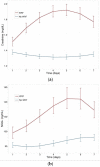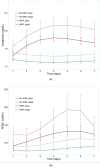Plasma Neutrophil Gelatinase-Associated Lipocalin and Predicting Clinically Relevant Worsening Renal Function in Acute Heart Failure
- PMID: 28698481
- PMCID: PMC5535961
- DOI: 10.3390/ijms18071470
Plasma Neutrophil Gelatinase-Associated Lipocalin and Predicting Clinically Relevant Worsening Renal Function in Acute Heart Failure
Abstract
The aim of this study was to evaluate the ability of Neutrophil Gelatinase-Associated Lipocalin (NGAL) to predict clinically relevant worsening renal function (WRF) in acute heart failure (AHF). Plasma NGAL and serum creatinine changes during the first 4 days of admission were investigated in 1447 patients hospitalized for AHF and enrolled in the Placebo-Controlled Randomized Study of the Selective A₁Adenosine Receptor Antagonist Rolofylline for Patients Hospitalized with Acute Decompensated Heart Failure and Volume Overload to Assess Treatment Effect on Congestion and Renal Function (PROTECT) study. WRF was defined as serum creatinine rise ≥ 0.3 mg/dL through day 4. Biomarker patterns were described using linear mixed models. WRF developed in 325 patients (22%). Plasma NGAL did not rise earlier than creatinine in patients with WRF. After multivariable adjustment, baseline plasma NGAL, but not creatinine, predicted WRF. AUCs for WRF prediction were modest (<0.60) for all models. NGAL did not independently predict death or rehospitalization (p = n.s.). Patients with WRF and high baseline plasma NGAL had a greater risk of death, and renal or cardiovascular rehospitalization by 60 days than patients with WRF and a low baseline plasma NGAL (p for interaction = 0.024). A rise in plasma NGAL after baseline was associated with a worse outcome in patients with WRF, but not in patients without WRF (p = 0.007). On the basis of these results, plasma NGAL does not provide additional, clinically relevant information about the occurrence of WRF in patients with AHF.
Keywords: NGAL; Neutrophil Gelatinase-Associated Lipocalin; acute heart failure; creatinine; heart failure; worsening renal function.
Conflict of interest statement
Mattia A.E. Valente, Kevin Damman, Dirk J. van Veldhuisen and Hans L. Hillege have nothing to disclose. Adriaan A. Voors has received speakers and consultancy fees from Merck and NovaCardia. Christopher M. O’Connor is a consultant to Merck. Michael M. Givertz has received honoraria and reimbursements from Bayer, Novartis, and Sevier, and NovaCardia, sponsors of the study, and from Merck, that purchased the rights to rolofylline after completion of the PROTECT pilot study. Piotr Ponikowski has received honoraria from Merck. Gad Cotter and Beth Davison are employees of Momentum Research Inc., which was contracted to perform work on the project by Merck & Co, Inc. John G.F. Cleland was on the Steering Committee for the study, served on the Advisory Board for MSD, and received payments for both. Michael M. Givertz has received institutional research support and served on a scientific Advisory Board for Merck. Daniel M. Bloomfield is an employee of Merck.
Figures




Similar articles
-
Neutrophil Gelatinase-Associated Lipocalin for Acute Kidney Injury During Acute Heart Failure Hospitalizations: The AKINESIS Study.J Am Coll Cardiol. 2016 Sep 27;68(13):1420-1431. doi: 10.1016/j.jacc.2016.06.055. J Am Coll Cardiol. 2016. PMID: 27659464
-
Plasma neutrophil gelatinase-associated lipocalin as a marker for the prediction of worsening renal function in children hospitalized for acute heart failure.Saudi J Kidney Dis Transpl. 2016 Jan;27(1):49-54. doi: 10.4103/1319-2442.174071. Saudi J Kidney Dis Transpl. 2016. PMID: 26787566
-
Serum neutrophil gelatinase-associated lipocalin (NGAL) in predicting worsening renal function in acute decompensated heart failure.J Card Fail. 2010 Jan;16(1):49-54. doi: 10.1016/j.cardfail.2009.07.003. Epub 2009 Aug 21. J Card Fail. 2010. PMID: 20123318 Free PMC article.
-
Biomarkers of Acute Kidney Injury after Cardiac Surgery: A Narrative Review.Biomed Res Int. 2019 Jun 27;2019:7298635. doi: 10.1155/2019/7298635. eCollection 2019. Biomed Res Int. 2019. PMID: 31346523 Free PMC article. Review.
-
The Review of Current Knowledge on Neutrophil Gelatinase-Associated Lipocalin (NGAL).Int J Mol Sci. 2023 Jun 21;24(13):10470. doi: 10.3390/ijms241310470. Int J Mol Sci. 2023. PMID: 37445650 Free PMC article. Review.
Cited by
-
Heart Failure and Cardiorenal Syndrome: A Narrative Review on Pathophysiology, Diagnostic and Therapeutic Regimens-From a Cardiologist's View.J Clin Med. 2022 Nov 28;11(23):7041. doi: 10.3390/jcm11237041. J Clin Med. 2022. PMID: 36498617 Free PMC article. Review.
-
Biomarkers in heart failure: the past, current and future.Heart Fail Rev. 2019 Nov;24(6):867-903. doi: 10.1007/s10741-019-09807-z. Heart Fail Rev. 2019. PMID: 31183637 Review.
-
Acute Cardiorenal Syndrome: Which Diagnostic Criterion to Use And What is its Importance for Prognosis?Arq Bras Cardiol. 2020 Jul;115(1):127-133. doi: 10.36660/abc.20190207. Epub 2020 Aug 7. Arq Bras Cardiol. 2020. PMID: 32813824 Free PMC article. English, Portuguese.
-
Biomarkers in Cardiorenal Syndrome.J Clin Med. 2021 Jul 31;10(15):3433. doi: 10.3390/jcm10153433. J Clin Med. 2021. PMID: 34362216 Free PMC article. Review.
-
Decompensated Heart Failure and Renal Failure: What Is the Current Evidence?Curr Heart Fail Rep. 2018 Aug;15(4):224-238. doi: 10.1007/s11897-018-0397-5. Curr Heart Fail Rep. 2018. PMID: 29987499 Review.
References
-
- Metra M., Davison B., Bettari L., Sun H., Edwards C., Lazzarini V., Piovanelli B., Carubelli V., Bugatti S., Lombardi C., et al. Is worsening renal function an ominous prognostic sign in patients with acute heart failure? The role of congestion and its interaction with renal function. Circ. Heart Fail. 2012;5:54–62. doi: 10.1161/CIRCHEARTFAILURE.111.963413. - DOI - PubMed
-
- Valente M.A., Voors A.A., Damman K., van Veldhuisen D.J., Massie B.M., O’Connor C.M., Metra M., Ponikowski P., Teerlink J.R., Cotter G., et al. Diuretic response in acute heart failure: Clinical characteristics and prognostic significance. Eur. Heart J. 2014;35:1284–1293. doi: 10.1093/eurheartj/ehu065. - DOI - PubMed
-
- Voors A.A., Davison B.A., Teerlink J.R., Felker G.M., Cotter G., Filippatos G., Greenberg B.H., Pang P.S., Levin B., Hua T.A., et al. Diuretic response in patients with acute decompensated heart failure: Characteristics and clinical outcome—An analysis from RELAX-AHF. Eur. J. Heart Fail. 2014;16:1230–1240. doi: 10.1002/ejhf.170. - DOI - PMC - PubMed
MeSH terms
Substances
LinkOut - more resources
Full Text Sources
Other Literature Sources
Miscellaneous

